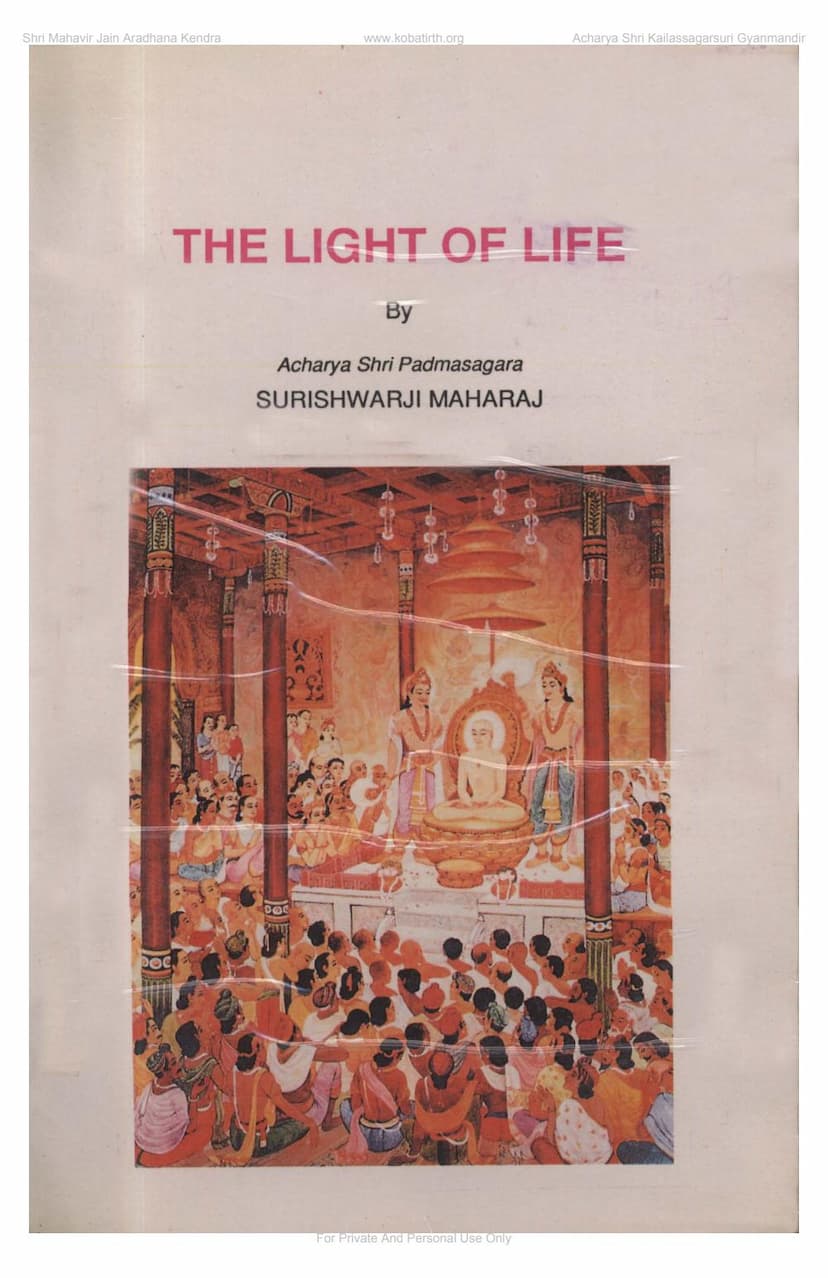Light Of Life
Added to library: September 2, 2025

Summary
Here's a comprehensive summary of the Jain text "The Light of Life" by Acharya Shri Padmasagarsuri, based on the provided pages:
Overall Purpose and Theme:
"The Light of Life" (English version of "Pravachan Parag") by Acharya Shri Padmasagar Surishwarji Maharaj, translated by Prof. K. Ramappa, is a collection of discourses aimed at guiding readers towards spiritual elevation and the ultimate goal of Moksha (liberation). The book emphasizes the importance of understanding and practicing the sublime doctrines of Jainism to purify and elevate the soul. The author stresses that the soul is more important than the body or wealth, and life's primary duty is the purification of the soul.
Key Concepts and Discussions:
The book delves into various fundamental aspects of Jain philosophy and spiritual practice, presented through the lens of question-and-answer discourse. Key themes include:
- The Nature of Questions and Knowledge: True knowledge stems from deep contemplation and sincere intellectual curiosity, not from superficial curiosity or the desire for ostentation. Questions arising from the depths of consciousness are valuable and lead to self-realization when answered with similar sincerity and focus.
- The Importance of Experiential Understanding: The book uses the analogy of a blind man trying to understand "brightness" to illustrate the limitations of verbal explanations and the necessity of direct experience. True understanding, like seeing light, comes from rectifying internal deficiencies (distortions of the mind) rather than relying on external explanations.
- The Necessity and Explanation of Dharma: Dharma is presented as the essential organizing principle of life, providing it with direction and sustenance, akin to food for the soul. It is not a bondage but a means to liberation from worldly attachments. Dharma is intrinsically linked to the soul; it is the soul's inherent nature (Vastu Sahao Dhammo), which needs to be awakened. True Dharma is the purity and sanctity of the inner self, not mere rituals.
- Anekantvad (The Multi-Dimensional Approach): This central Jain principle is highlighted as crucial for resolving conflicts and understanding truth. It involves considering multiple perspectives and finding common ground, preventing dogmatism and promoting harmony. The example of the frogs debating the movement of the log illustrates the dangers of one-sided views.
- The Meaning of Moksha: Moksha is described as the perfection of life, a state where the soul, freed from causes, effects, actions, desires, and temptations, merges with the supreme reality. It's the cessation of the cycle of birth and death, achieving a pure, formless, and eternal state.
- The Role of Faith and Endeavor: Achieving spiritual goals requires faith and consistent endeavor. Temptation, fear, and ultimately love are presented as pathways to motivate spiritual practice. Genuine faith is paramount, as intellectual arguments alone are insufficient for spiritual realization.
- Purity of Food and Speech: The book emphasizes the impact of food on thoughts and the mind, and the critical role of speech (Bhasha Samiti) in spiritual progress. Speech should be brief, truthful, pleasant, relevant, dignified, and free from arrogance and negativity. Restrained and mindful speech is crucial for spiritual well-being.
- Contemplation (Chintan): Contemplation is depicted as a divine fire capable of burning away sinful karmas and leading to spiritual purity. It is contrasted with "Chinta" (worry), which leads to worldly entanglement.
- Brahmacharya: This is highlighted as the foundation for spiritual growth and austerity, essential for overcoming negative propensities like anger and jealousy.
- Punya and Papa: Punya is the result of noble conduct and intentions that elevate the soul, while Papa is what causes spiritual decline. Benevolence brings Punya, and malevolence brings Papa.
- The Importance of Humility and Self-Scrutiny: True spiritual progress requires humility and introspection. Arrogance and egoism (Aham) are seen as impediments, while selflessness (Naham) and a sincere desire for knowledge are essential.
- The Greatness of Sadhus: Sadhus are presented as spiritual guides, doctors, and messengers of Dharma who help individuals purify their souls, overcome karmas, and achieve spiritual goals. They are dedicated to their spiritual endeavors and detached from worldly concerns.
- The Value of Silence: Silence is considered a powerful spiritual austerity that stills the mind, enhances contemplation, and leads to self-realization.
- The True Nature of the Soul: The soul is immortal, pure, and distinct from the body. Realizing this distinction (Bheda Vijnan) is fundamental to spiritual progress and liberation.
- The Power of Right Endeavor: The book consistently stresses that spiritual goals, like Moksha, are attained through personal effort and right endeavors, guided by Dharma and the teachings of the enlightened. The example of Arjuna aiming at the bird's eye illustrates the importance of a clear aim and focused effort.
Overall Message and Call to Action:
"The Light of Life" serves as a spiritual guide, urging readers to turn inward, purify their minds and souls, and actively pursue Dharma through sincere endeavors. It encourages a life of ethical conduct, detachment from worldly possessions, and unwavering faith in the path shown by the enlightened beings of Jainism. The ultimate message is that spiritual realization and liberation are attainable through self-effort, guided by wisdom and devotion.